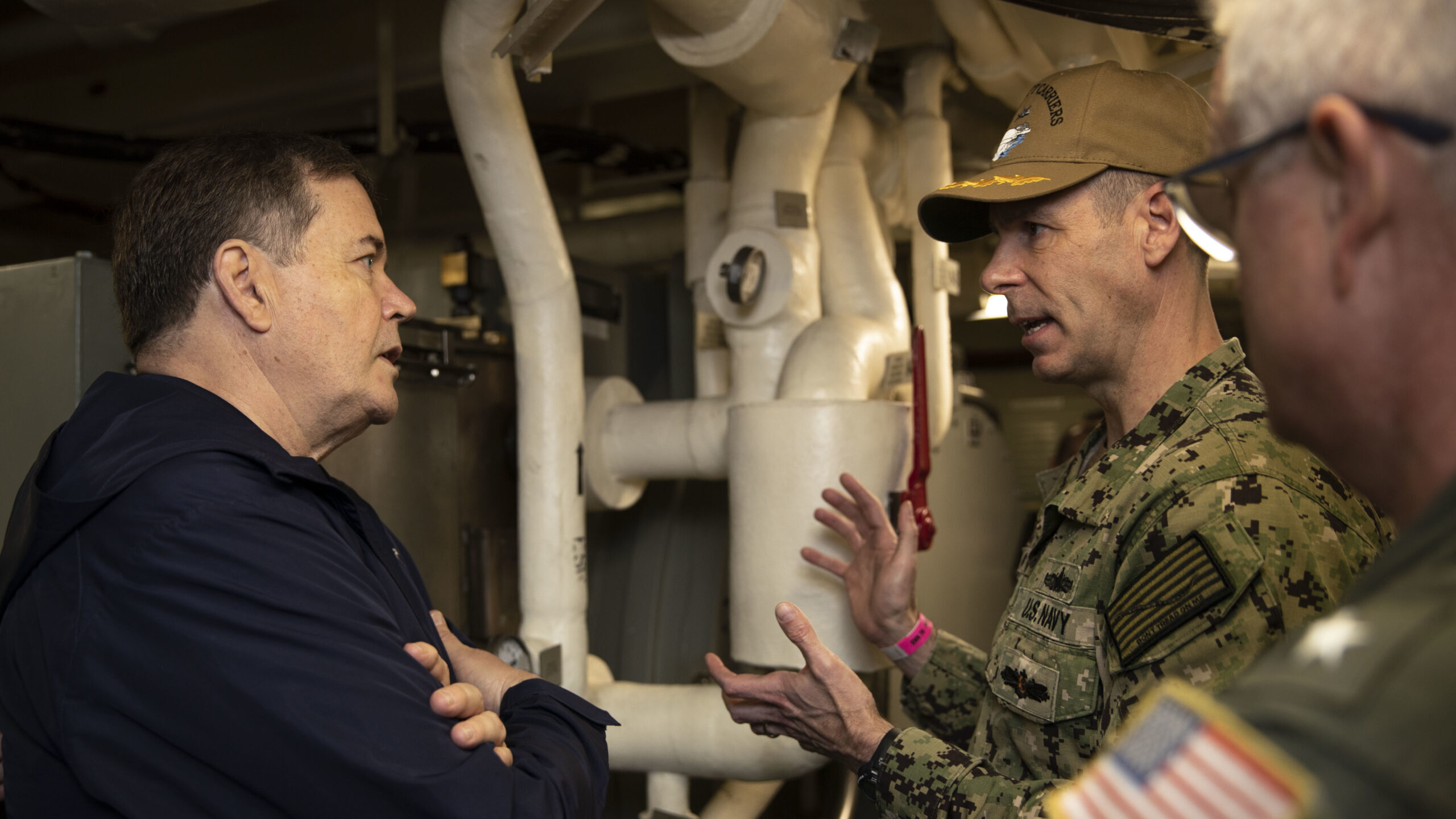
Raymond O’Toole, acting director of operational test and evaluation, left, speaks with Capt. Brian Metcalf, PMS 378 program manager, in one of USS Gerald R. Ford’s electromagnetic aircraft launch system motor generator rooms during a ship visit, May 19, 2021. (US Navy/Mass Communication Specialist 3rd Class Angel Thuy Jaskuloski)
WASHINGTON: Every January, defense acquisition geeks receive a gift in the form of the annual report by the Pentagon’s independent weapons tester. This dense, detailed report is sometimes the best view experts and reporters get into the technical problems a weapons program may be facing, whether that’s an F-35 gun that can’t shoot straight or safety concerns about the president’s new helicopter.
But next year, the Pentagon’s office of the Director of Operational Test and Evaluation will issue two different versions of the 2021 report: An unclassified version that will be available to the public, and a version with “controlled unclassified information” (CUI) that will only be made available to lawmakers and those inside the department, according to Raymond O’Toole, acting head of the DOT&E office.
“I thought it very important to provide Congress and the Secretary the test evaluation details that shouldn’t wind up in our adversaries’ hands, hence the new CUI version of the annual report,” he said at an event hosted Monday by the National Defense Industrial Association.
O’Toole said the office has already generated the CUI version of the report and is now “parsing out” what information will be cleared for the public version. Both are on track to be released in January.
The DOT&E is charged with providing independent assessments to Pentagon leadership about whether a weapon will meet requirements in an operational environment, providing important oversight for acquisition programs that allows department leaders to better understand how a system will perform in combat.
The annual report provides a detailed accounting of what a weapons program accomplished in a given year, as well as any technical flaws or concerns encountered during development and operations. DOT&E is required by law to submit an unclassified version of the report every year.
Mandy Smithberger, director of defense information for the Project On Government Oversight, raised concerns that most technical details could be pushed to the CUI version, leaving the unclassified version a shell with little relevant insight.
“DOT&E already has the ability to include classified reporting, and I worry that this will end up [resulting] in a watered down version of the report that makes it more difficult for the press and the public to make sure that we are buying weapon systems that are effective and safe,” she said in an email to Breaking Defense.
“Public exposure of problems in these programs is often essential to making sure major deficiencies get fixed,” she added. “I’m very concerned that this decision will make it less likely that will happen in the future.”
Ankit Panda, a nuclear policy expert with the Carnegie Endowment for International Peace, also said the decision to develop two different versions could be a step in the wrong direction.
“I see this as yet another lamentable sign of the Pentagon backing away from transparency in favor of opacity for little good reason,” he said. “Keeping Congress up to date is important, but fragmenting reporting in this way is counterproductive.
But O’Toole said DOT&E is already going the extra mile by ensuring that an unclassified version of the report is released to the public at all. O’Toole said he consulted with the Pentagon’s legal counsel to determine whether the controlled report would fulfill the legal requirement to release an unclassified version.
“And the answer I got back was, yes. However, I recognize that [for] Congress, that is not meeting really the spirit of the law,” he said.
O’Toole also stated that the decision about what constitutes “controlled unclassified information” ultimately rests with the services, not DOT&E itself.
“You will see some information in there on one program, and it’s gonna be missing on another program,” he said.
In short, if the report doesn’t provide detailed information about a certain aspect of a weapon system — even the types of data provided for other programs — don’t blame DOT&E.
Pass a preemptive CR, deal with inflation and watch the debt limit: 3 tasks for Congress
John Ferrari and Elaine McCusker of AEI argue in this op-ed that Congress needs to act quickly to ensure American national security before getting bogged down in election season.


























